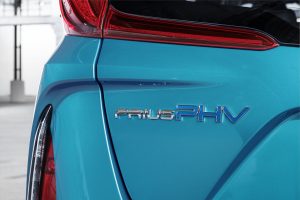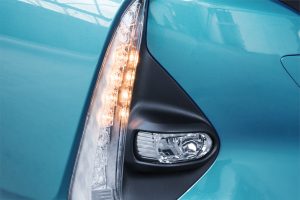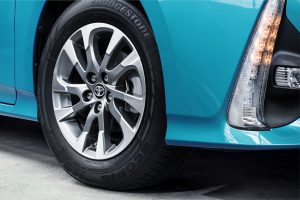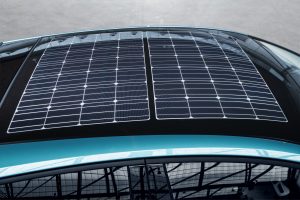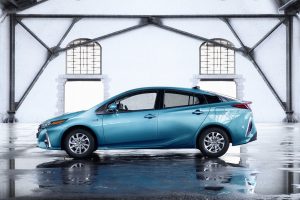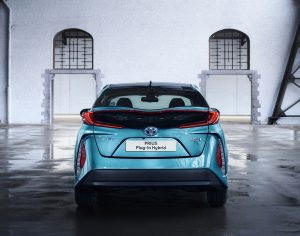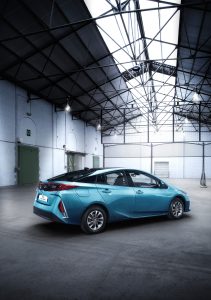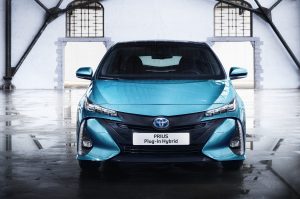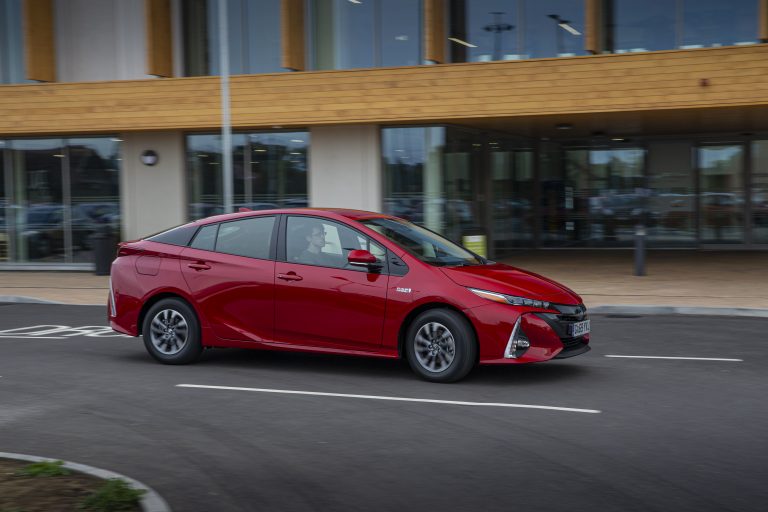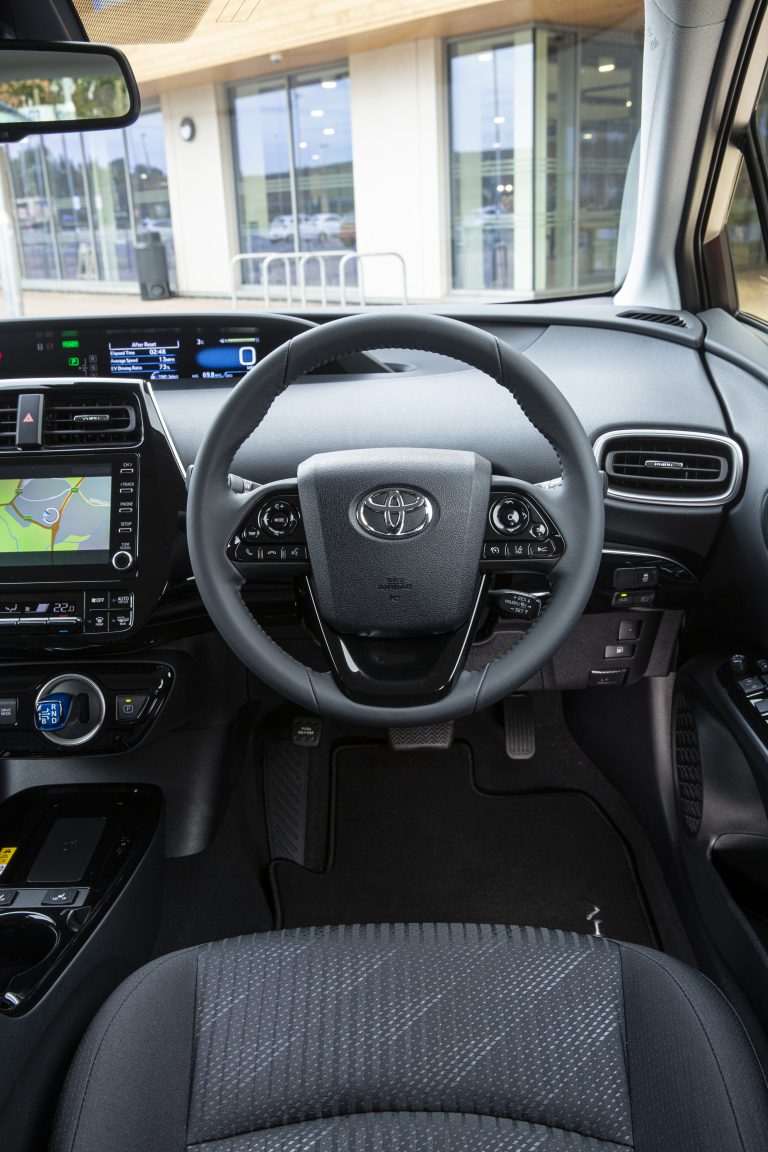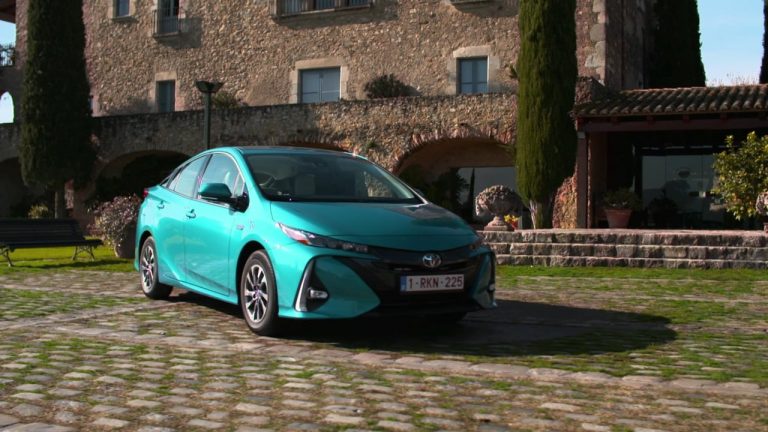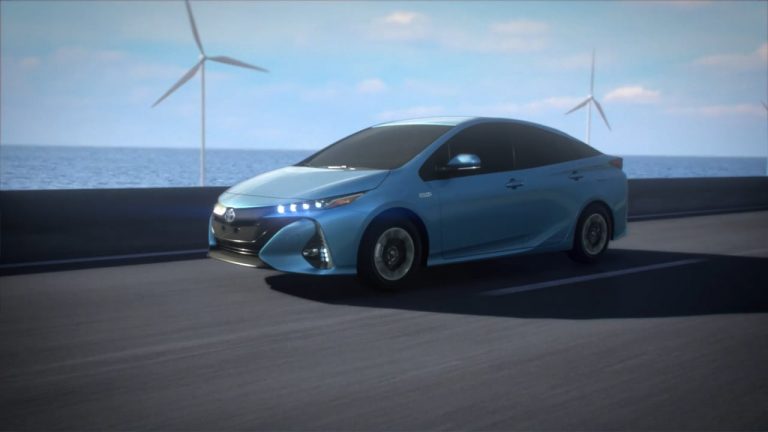The New Toyota Prius Plug-in Hybrid
Paris motor show press information*
The new Prius Plug-in Hybrid combines all the attributes of the fourth generation Toyota Prius with a class-leading all-electric driving range and a series of highly innovative technologies.
Toyota was the first car manufacturer to offer the world Plug-in Hybrid Vehicle (PHV) technology. With the launch of the second generation Prius Plug-in Hybrid, it is taking a further step towards its goal of reducing its whole-fleet CO2 emissions by 90 per cent* by 2050, a target that will also be supported by hybrid, electric and fuel cell vehicle technologies.
Toyota’s new PHV is a powerful response to customer feedback on the original Prius Plug-in. It is not just an evolution of the latest generation Prius, it is a significant vehicle in its own right.
It features sophisticated technology breakthroughs, including a Dual Motor EV drive, a battery warning system and – in two world-firsts – an EV range-extending solar roof and gas injection heat pump automatic air conditioning.
The new Prius Plug-in Hybrid has an EV driving range of more than 30 miles – double the distance achieved by its predecessor – and represents a major advance in efficiency, driving performance, innovation and styling.
State-of-the-art PHV technology, impressive EV driving experience
The latest generation of Toyota’s PHV technology is at the heart of the new Prius Plug-in Hybrid. Effectively it offers customers two cars in one: a more sophisticated full hybrid powertrain and an EV all-electric driving capability that has twice the range of the previous Prius Plug-in.
The significant increase in EV driving range is based on technological improvements in three key areas: battery development; maximised EV driving performance; and increased battery recharging speed.
The large-capacity lithium-ion battery, located beneath the loadspace, is key to Prius Plug-in’s 30-mile-plus EV range. Its volume has been increased from 87 to 145 litres and its energy capacity doubled from 4.4 to 8.8kW/h, yet at 120kg it is only 50 per cent heavier than its predecessor.
EV power has been increased by 83 per cent, thanks to the development of a Dual Motor Drive System, featured for the first time in Toyota hybrid powertrain. A new, highly compact clutch within the transaxle allows the hybrid system generator to act as a second electric motor. This boosts EV driving power to 68kW, giving better acceleration and even more engaging performance, while at the same reducing the frequency with which the petrol hybrid engine is brought into play.
A more efficient new PHV system, building on the quality of the fourth generation full hybrid technology deployed in the new Prius, further helps maximise the vehicle’s EV performance potential.
In a world-first, the automatic air conditioning is powered by a gas injection heat pump, capable of heating the cabin without having to start the engine, even when external temperatures drop as low as -10°C. This minimises the impact heating the car’s interior has on the EV driving range.
The heat pump is far more efficient than engine heating or high-power electric water heaters, being able to warm the cabin efficiently using heat absorbed from the outside air. The gas injection mechanism mounted on the pump gives the system its ability to operate even when outside temperatures are low.
Moreover, during charging, a new battery warming system will heat the cells to an efficient working temperature, in outside conditions are as cold as -20°C. This ensures that battery power and efficiency are maintained at level sufficient to minimise any cold weather impact on the EV driving range. Effectively, full power it available right from start-off, even in very cold weather.
Maximum charging power has been increased from 2.0 to 3.3kW. The battery can be fully charged up to 65 per cent more quickly – in just two hours using a Type II Mode III Mennekes connector, or three hours 10 minutes using a standard household plug socket. The charging process can now be programmed for a week on a day-to-day basis, including the facility to simultaneously charge the battery and pre-heat or pre-cool the cabin.
The new transaxle is combined with a new, highly efficient Power Control Unit to give Prius Plug-in exceptional overall operating efficiency. Improved EV and HV driving performance are combined with targeted average fuel consumption of 282.5mpg and CO2 emissions of 22g/km.
Striking, stand-alone styling
The new Prius Plug-in shares the same Toyota New Global Architecture (TNGA) platform as the latest Prius, but its striking, highly aerodynamic design builds on the Prius’s profile with new styling elements that evoke the advanced technology that is present beneath the skin.
The car measures 4,645mm long, 1,760mm wide and 1,470mm high, making it 165mm longer, 15mm wider and 20mm lower than its predecessor. Compared to the current Prius, the front and rear overhangs are longer by 25 and 90mm respectively. A reduction in the height of the cowl and the rear spoiler further emphasises the car’s sleek wide silhouette and low centre of gravity.
In a powerful evocation of Toyota’s contemporary design themes, the front of the car is instantly distinguishable from the standard Prius because of its prominent acrylic grille treatment and thin, ultra-compact four-LED (adaptive) headlamp units.
The strong, forward projection of the grille is given extra emphasis by the aerodynamic sculpting of the sides of the bumper, while the vertical alignment of the daytime running lights and LED turn indicators at the furthest edge of the front wings reinforces the vehicle’s low, ground-hugging stance.
In profile, Prius Plug-in can be identified by its longer rear overhang, its lower cowl and rear spoiler, and by two-tone 15-inch alloys that are specific to the model and designed to provide extra brake cooling.
At the rear the cross section of the “double-bubble” screen is carried through into the curve of the spoiler. LED light clusters, also unique to the plug-in hybrid, are integrated into the extremities of the spoiler.
A comprehensive aerodynamics package plays a central role in reducing fuel consumption, giving Prius Plug-in a 0.25 coefficient of drag.
The car builds on the efficient aerodynamic styling of Prius, adopting a lower height roof and rear spoiler, a larger area of underbody covers, front and rear bumper corners profiled to rectify airflow, the “double-bubble” rear screen and aero stabilising fins built into the rear combination lamps.
In addition, Prius Plug-in features a shutter in the front grille which automatically opens and closes are necessary to optimise the flow of cooling air into the engine compartment, reducing air resistance. When the engine is cold, the shutter remains closed to suppress airflow and reduce engine warm-up time, contributing to lower fuel consumption.
Interior design
The new Prius Plug-in Hybrid shares the same dashboard design as the latest Prius, with a clear structural arrangement of layered information which places the driver’s meters at a distance and the displays closer at hand.
It benefits from the larger, eight-inch infotainment screen with updated graphics. The dual 4.2-inch TFT meters also feature PHV-specific graphics. The instrument panel also differs from that in Prius with its high-quality satin chrome-plated trim, and there is what base to the shift panel.
The front seats, too, are shared with the conventional Prius, offering improved cushion comfort to reduce driver fatigue. In the rear there are two seats separated by a centre console.
The luggage deck has been raised by 160mm to accommodate the larger plug-in hybrid system, resulting in maximum loadspace volume of 360 litres.
Advanced technology for greater efficiency
Every aspect of the advanced technology deployed in the new Prius Plug-in has been designed to improve the efficiency of the PHV powertrain and to promote and environmentally conscious lifestyle.
This includes the successful development of the solar roof technology first seen on the Auris HSD concept in 2010. Prius Plug-in’s roof can incorporate a large solar panel which generates electricity to the charge the hybrid system battery.
When the vehicle is parked, but not connected to a charging socket, the solar roof charges a solar battery, which when fully charged itself delivers a pumping charge to the main hybrid battery.
Solar charging can increase the car’s EV driving range up to maximum of around three miles every day – the equivalent of 620 miles of all-electric driving in a year.
The driving models available now includes Battery Charge Mode which uses he engine to generate electricity and charge the battery when the vehicle is running in HV mode.
The new dual-zone air conditioning system is equipped with S-flow control which automatically operates the cabin vents in relation to which seats are occupied, maintaining comfort while reducing power consumption.
The multi-LED headlights also use less power and efficiency is supported by the use of lightweight carbon fibre reinforced plastic (CFRP) for the tailgate – a first for a mass-production vehicle.
High-tech equipment features include a wireless phone charging tray, large colour head-up display and a new Simple Intelligent Parking Assist (S-IPA) system. An enhanced Toyota Safety Sense package introduced to new features to Toyota’s PHV – Pre-Collision Safety with a pedestrian recognition function and all-speed Adaptive Cruise Control, capable of slowing the car to standstill if required.
TNGA platform
The Toyota New Global Architecture-based platform plays a defining role in Prius Plug-in’s rewarding driving experience, giving the car a lower centre of gravity compared to the current model and securing a more involving driving position and more precise and responsive handling, with less body roll.
These qualities are enhanced by the car’s new double wishbone rear suspension, which produces one third the level of shock when driven on uneven roads compared to the current model. To achieve better handling with more direct response, the front MacPherson strut suspension has also been revised.
The significantly improved dynamic characteristics of the new chassis are matched by the more responsive character of the new plug-in full hybrid system. The 83 per cent boost in EV power due to the new Dual Motor Drive System offers drivers highly responsive acceleration
Finally – and complementing the quietness that comes with car’s increased EV capabilities – a particular focus has been placed on minimising noise and vibration. Sound-suppressing and absorbing materials have been strategically placed to secure excellent quietness levels in the cabin.
Provisional technical specifications
| 1.8 PLUG-IN HYBRID | |
| Engine | |
| Displacement (cc) | 1,798 |
| Max. power (bhp/kW @ rpm) | 98/73 @ 5,200 |
| Max. torque (bhp/kW @ rpm) | 142 @ 4,000 |
| Transmission | e-CVT |
| Performance | |
| Fuel consumption (mpg) | 282.5** |
| CO2 emissions (g/km) | 22** |
| EV Performance | |
| Max. EV speed (mph) | 84 |
| Max. EV range (miles) | >30 |
| Max. EV power (kW) | 68 |
| Battery | |
| Type | Lithium-ion |
| No of cells | 95 |
| Power (kW) | 8.8 |
| Volume (l) | 145 |
| Weight (kg) | 120 |
| Max. charging power (kW) | 3.3 |
| Max, charging time (hours) | 2.0 |
| Dimensions | |
| Overall length (mm) | 4,645 |
| Overall width (mm) | 1,760 |
| Overall height (mm) | 1,470 |
| Coefficient of drag (Cd) | 0.25 |
* Model specifications and performance data are for international markets; UK-specific information will be announced later. ** Figures provisional subject to homologation.



